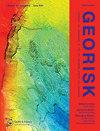Correlation of Ground Deformation Induced by the 6 February 2023 M7.8 and M7.5 Earthquakes in Turkey Inferred by Sentinel-2 and Critical Exposure in Gaziantep and Kahramanmaraş Cities
IF 4.8
3区 工程技术
Q1 ENGINEERING, GEOLOGICAL
Georisk-Assessment and Management of Risk for Engineered Systems and Geohazards
Pub Date : 2023-07-06
DOI:10.3390/geohazards4030015
引用次数: 1
Abstract
On 6 February 2023, an M7.8 devastating earthquake started rupturing the East Anatolian fault system in Turkey, resulting in intense shaking that lasted over a minute. A second earthquake of magnitude 7.5 struck near the city of Elbistan a few hours later. Both of these events are associated with the East Anatolian fault system. The earthquake sequence caused widespread damage and collapse of structures in densely populated areas throughout the Southern Turkey and Northern Syria regions and a very large number of human losses. This study focuses on the correlation of the ground deformation with the critical exposure of the infrastructures of Gaziantep and Kahramanmaraş cities. The estimation of the ground deformation of the affected area is achieved with the use of Copernicus Sentinel-2 products and the Normalized Cross Correlation algorithm (NCC) of image matching. The results of the East–West component show that specific sections of the region moved towards the East direction, reaching displacement measurements of 5.4 m, while other sections moved towards the West direction, reaching displacement measurements of 2.8 m. The results of the North–South component show that almost the whole affected area moved towards the North direction, with specific areas reaching displacements of 5.5 m, and a few exemptions, as some areas moved towards the South direction, with displacements reaching even 6.9 m. Regarding the cities of Kahramanmaraş and Gaziantep, their estimated movement direction is North-West and North-East, respectively, and is consistent with the movements of the Arabian and Anatolian Plates in which they are located. Important infrastructures of the study areas (education, museums, libraries, hospitals, monuments, airports, roads and railways) are superimposed on the findings, enabling us to detect the critical exposure rapidly.2023年2月6日土耳其加济安泰普和kahramanmaraku市的Sentinel-2和临界暴露推断的7.8级和7.5级地震诱发地面变形的相关性
2023年2月6日,土耳其东安纳托利亚断层系统发生7.8级毁灭性地震,导致持续一分钟多的强烈震动。几小时后,伊尔比斯坦市附近发生了第二次7.5级地震。这两个事件都与东安纳托利亚断裂系统有关。在整个土耳其南部和叙利亚北部地区的人口稠密地区,地震序列造成了广泛的破坏和建筑物倒塌,并造成了大量人员损失。本文主要研究了加济安泰普和kahramanmaraku两个城市的地面变形与基础设施临界暴露的相关性。利用哥白尼Sentinel-2产品和图像匹配的归一化互相关算法(NCC)实现了灾区地面变形的估计。东西分量的结果表明,该地区的特定路段向东移动,位移测量值为5.4 m,而其他路段向西移动,位移测量值为2.8 m。南北分量的结果表明,几乎整个受灾地区都向北移动,个别地区的位移达到5.5 m,少数地区的位移也向南移动,甚至达到6.9 m。关于kahramanmaraku和Gaziantep的城市,估计它们的运动方向分别是西北和东北,与它们所在的阿拉伯和安纳托利亚板块的运动一致。研究区域的重要基础设施(教育、博物馆、图书馆、医院、纪念碑、机场、公路和铁路)叠加在调查结果上,使我们能够迅速发现关键的暴露。
本文章由计算机程序翻译,如有差异,请以英文原文为准。
求助全文
约1分钟内获得全文
求助全文
来源期刊
CiteScore
8.70
自引率
10.40%
发文量
31
期刊介绍:
Georisk covers many diversified but interlinked areas of active research and practice, such as geohazards (earthquakes, landslides, avalanches, rockfalls, tsunamis, etc.), safety of engineered systems (dams, buildings, offshore structures, lifelines, etc.), environmental risk, seismic risk, reliability-based design and code calibration, geostatistics, decision analyses, structural reliability, maintenance and life cycle performance, risk and vulnerability, hazard mapping, loss assessment (economic, social, environmental, etc.), GIS databases, remote sensing, and many other related disciplines. The underlying theme is that uncertainties associated with geomaterials (soils, rocks), geologic processes, and possible subsequent treatments, are usually large and complex and these uncertainties play an indispensable role in the risk assessment and management of engineered and natural systems. Significant theoretical and practical challenges remain on quantifying these uncertainties and developing defensible risk management methodologies that are acceptable to decision makers and stakeholders. Many opportunities to leverage on the rapid advancement in Bayesian analysis, machine learning, artificial intelligence, and other data-driven methods also exist, which can greatly enhance our decision-making abilities. The basic goal of this international peer-reviewed journal is to provide a multi-disciplinary scientific forum for cross fertilization of ideas between interested parties working on various aspects of georisk to advance the state-of-the-art and the state-of-the-practice.

 求助内容:
求助内容: 应助结果提醒方式:
应助结果提醒方式:


